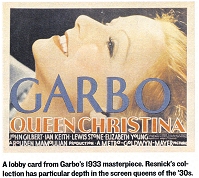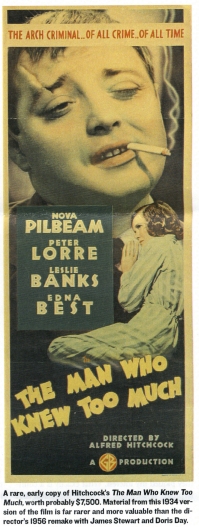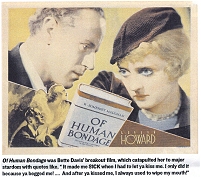INTERVIEW FROM THE FORBES COLLECTOR
Vintage Film Posters
 Many dealers I meet started out as collectors, getting into the business so they could cherry-pick the best material, support their collecting habit and share their passion and expertise with others. Such is the case with Ira Resnick, an avid collector of vintage movie posters since his college days in the 1960s.
Many dealers I meet started out as collectors, getting into the business so they could cherry-pick the best material, support their collecting habit and share their passion and expertise with others. Such is the case with Ira Resnick, an avid collector of vintage movie posters since his college days in the 1960s.
Resnick had long collected paper. As a boy in New Rochelle, he built a large, quirky postcard collection—picturing everyone from silent and golden age movie stars to Evelyn Nesbit, the femme fatale in the infamous Stanford White murder case. After attending New York University film school, he worked as a freelance photographer for 15 years, much of it in Califonia. When Resnick returned to New York in the early ‘80s, he decided to switch gears and follow his passion for movie posters. He started his gallery, Motion Picture Arts, in 1982.
Now his collection has swelled to more than 200 vintage one-sheets and thousands of other pieces, from lobby cards, window cards and inserts to a 24-sheet poster for The Awful Truth. Having stepped down this year after six years as chairman of the Film Society of Lincoki Center, Resnick recently exhibited 30 favorite posters from his collection at the Walter Reade Theater in Manhattan. He also collects vintage photographs, from Man Ray and Edward Weston to all manner of film-related photos: stills, location snaps and glamour head shots. I visited his New York office to get a tour of the collection.
 How did you get stated? What attracted you?
How did you get stated? What attracted you?
I’d studied film in school and loved old movies, which back then you could only watch on the late late show, or at revival houses, institutions that have now gone the way of the dinosaur. I realized that one of the only ways I could own a piece ol the old movies was to buy a poster or a lobby card.
What was your first acquisition?
I bought my first posters in 1969 at Cinemabilia in Greenwich Village. Often these places were counter shops, and the people were not very nice. If you bought a lot, sometimes they would be alit-tie less rude. I bought one-sheets for The Awful Truth and Love Before Breakfast (which shows Ca-role Lombard with a black eye) for $35 each. The Carole Lombard at auction would now be worth $5,000—$l0,000. I also bought a one-sheet for Grand Hotel, but I later realized that it was a 1962 reissue—my first lesson in connoisseurship.
So film posters weren’t big collectibles back then?
Not at all In the early 60s, people pretty much priced them by year and size. Posters from the ‘30s and the ‘40s sold for only a few dollars each. In the ‘60s, college kids like myself began discovering the icons of old film—like the Marx Brothers and Bogart—helping spur the collecting movement. People began to realize that there was a treasure trove out there. Little by little, shops started to open around the country—on Hollywood Blvd., in San Francisco, in New York Occasionally you’d find posters at flea markets and antique shops.
Was there a standard to how many posters and lobby cards were designed for each film?
Usually each film had two one-sheets (27 x 41 inches), two half-sheets (22 x 28), two inserts (14 x 36), one lobby card set (11 x 14) and window cards (14 x 22). It went up from there: three-sheets, six-sheets and occasionally 24-sheets, which were almost billboard size. The lobby card set usually included a title card and seven notable scene cards. Two one-sheets was pretty standard, except for blockbusters like The Wizard of Oz or Gone with the Wind, for which the studio put out three or four poster designs.
How do you decide what to buy and what not to?
I have always tried to collect Hollywood history—the great films and the great stars (especially my favorites)—along with beautiful graphics. I especially love the silents and the ‘30s era. My collection is chockful of the old romantic comedy titles like It Happened One Night and Holiday. Dramas too, like Of Human Bondage or Dodsworth, which to me is one of the great films of all time. I also collect stars, like Louise Brooks, whose material has gotten harder to find as more people jump into the game. The most expensive poster I ever sold was from a Louise Brooks film, Diary of a Lost Girl, a German movie from 1929. It sold for $80,000.
What’s the difference in value between posters made in the originating country and those made elsewhere?
Usually the country of origin is what collectors want. But there are always exceptions. There’s an Italian artist, Ballester, whose designs were so gorgeous, like posters he did of Rita Hayworth. Whereas another Italian poster would maybe cost $1,000, his could run $5,000—$lO,000.
Are there other artists whose names add value?

Regionalist painter Thomas Hart Benton designed a poster for The Grapes of Wrath. Norman Rockwell freelanced for the studios, designing posters like The Magnificent Ambersons. Al Hirschfeld worked at MGM in the 1930s and did a lot of Marx Brothers films. Varga did several, like Moon Over Miami with Betty Grable and Ziegfeld Follies. Those are some of the biggest names.
What are the important themes within your collection?
One would be highlights of film history, starting with my earliest poster, a 1913 Mary Pickford film called The Informer, and moving forward. As I mentioned before, I have a particularly deep vein of 1930s film material.
Another important subtheme is women through the ages of Hollywood, from the little-known silent-era stars like Louise Brooks to contemporary figures like Uma Thurman in Pulp Fiction—from the vamp to the camp to the tramp. I have large collections of Katharine
Hepburn and Bette Davis, and significant title card collections for both Jean Harlow and Greta Garbo. I love them all, even little-known women like silent-era director Lois Weber and silent-era comedienne Constance Talmadge. Very few other people collect them. Their material has far less competition than that of, say, Katharine Hepburn.
Are there periods or genres that command a premium?
 The biggest ticket items have always been the classic horror films. The rarest ones, like Mummy and Frankenstein, have brought in the low to mid six figures. Other high-value material? Three Stooges posters. There are avid collectors who will knock each other over the head, just the way the Stooges did, to get things. Also sought after: sports titles, film noir and 1950s sci-fi. A lot has to do with each generation and which movies resonate.
The biggest ticket items have always been the classic horror films. The rarest ones, like Mummy and Frankenstein, have brought in the low to mid six figures. Other high-value material? Three Stooges posters. There are avid collectors who will knock each other over the head, just the way the Stooges did, to get things. Also sought after: sports titles, film noir and 1950s sci-fi. A lot has to do with each generation and which movies resonate.
When the market started to go to James Bond and more modern titles, I personally lost interest. Sure, I’ll buy some Woody Allen, Mel Brooks or Jack Nicholson in The Shining, but I’m very selective with later material. My most contemporary poster is a one-sheet for Pulp Fiction, It appeals to me, but not in the same way as older stuff does.
Where do you buy?
I do buy at auctions, because it’s easy And I get first crack at material that’s offered to the gallery. My gallery director knows my taste, so he’ll cull from what’s out there, emailing me things he finds online, where much of the poster business takes place today. Sometimes you come across the poster stash of an old projectionist or a construction teardown that used lobby cards as insulation. That doesn’t happen too much any more.
What about Ebay? Do you buy much there?
On Ebay I buy stills here and there. But in general I don’t buy much these days. I’m more likely to be trading up to get better examples of movies I love. Or saving my money for the important posters, like Son of the Sheik, which is the latest one I bought. It was Rudolph Valentino’s last film, from 1926. The poster’s in beautiful condition and very rare. It cost $25,000, with some trade involved.
Is trade still a big part of the business?
People do it. But I would rather buy than trade. Nobody wants to be taken advantage of. To get quality you have to give up quality.
Who were your mentors in this field?
 I learned from other dealers, like José Carpio of Cinemonde in San Francisco and John Kobal, in Hollywood. Then there was James Card, who ran Eastman House; he brought Louise Brooks out of alcoholic obscurity, up to Rochester. I learned a lot about old movies in the few years I knew him. He wrote a great book about growing up with silent films. I bought a lot of his collection.
I learned from other dealers, like José Carpio of Cinemonde in San Francisco and John Kobal, in Hollywood. Then there was James Card, who ran Eastman House; he brought Louise Brooks out of alcoholic obscurity, up to Rochester. I learned a lot about old movies in the few years I knew him. He wrote a great book about growing up with silent films. I bought a lot of his collection.
In the days when I used to spend time in the gallery, I often learned from the customers, serious movie buffs like this old guy who personally knew a lot of the character actors of the silent era. Then we have the occasional movie stars or the screenwriters who come in, like Uma Thurman and Benicio del Toro. That’s always fun.
What did Uma buy?
Wonderfully graphic Polish posters. Benicio bought Italian neo-Realists. And Alec Baldwin bought Nightmare Alley, a great ‘40s noir poster.
What effect does condition have on value?
Very often you can get a better buy when something has condition issues. In 1986 I bought my The Babe Comes Home poster, from Babe Ruth’s second film foray, a romantic comedy about— what else?—a baseball player. It cost me $600, unbacked and needing light restoration. If it were pristine, it would have cost about $1,500.
What are the most common condition problems?
Posters were generally shipped to the theaters flat, folded once length-wise and three times across. So you often have to deal with creases and losses in those areas. In general, you don’t want to see tremendous loss from important parts of the image, like the stars’ faces. Unframed or improperly framed, paper can become brittle, yellowed or faded. That could slash value. A Wizard of Oz poster came into the gallery that would’ve been worth $10,000; but because it was yellowed, we paid $1,000. Vivid colors are key. But some things are so rare that you get it in whatever shape you can get it.
How do you preserve this material?
I frame posters with UV Plexiglas and always keep them out of direct sunlight. If they are on linen you can roll them. I like to keep lobby cards in beautiful albums or archival boxes. Those you shouldn’t roll. I store a lot of material in fireproof flat files. Linen backing is crucial for old posters, because the old paper really crumbles. Purists prefer Japanese rice paper, but linen is usually fine.
What’s kosher, restoration-wise?
It depends on if you’re going to keep it or resell it. You want to make sure it has a backing and maybe just touch up the folds. In general, less restoration is better. ‘When you start to really paint in the losses—these days, restorers can recreate almost anything—it’s a case-by-case decision. With certain posters, it’s kosher to “cherry it out” and make it look brand new. I prefer that to being hit in the face with defects. But some collectors don’t want to put that kind of money into it, or are purists about having something repainted.
What’s your most valuable poster?
Probably the Babe Ruth. I bought it 20 years ago for $600 and now it would probably sell for at least $100,000. There are only two known copies. The other one reportedly sold at Heritage Auctions for $120,000, but then it showed up in a later auction. I always thought that in the right auction, it might sell for a quarter of a million. But I don’t want to sell it. It’s the one everyone wants to trade me for.
I have several posters in the $20,000—$30,000 range, like Thief of Baghdad, the Douglas Fairbanks’ Robin Hood and Black Pirate. I have Les Enfants du Paradis, a French first panel. It’s enormous. And a great German Dietrich poster of Blonde Venus, which I think is the most beautiful image of that film. They’re all quite valuable.
What mistakes can you counsel collectors to avoid?
 It’s important to do your research. A lot of people who don’t know better get stuck with later reissues, like I did with my first copy of Grand Hotel. First, look for the date down at the bottom right. It will usually say R (for “reissue”) and the date. With It Happened One Night, they reissued the 1934 film in 1937, the only difference being the mention of the Oscar. Then you look for full color. The reissues were very often a duotone. When they redid a ‘30s poster in the ‘40s, for example, they often just used two colors. But some reissues have pretty serious value. There is an R38 of Frankenstein that is quite good, if you’re not a purist who needs the original. The R38 could be in low five figures versus low six figures for the original.
It’s important to do your research. A lot of people who don’t know better get stuck with later reissues, like I did with my first copy of Grand Hotel. First, look for the date down at the bottom right. It will usually say R (for “reissue”) and the date. With It Happened One Night, they reissued the 1934 film in 1937, the only difference being the mention of the Oscar. Then you look for full color. The reissues were very often a duotone. When they redid a ‘30s poster in the ‘40s, for example, they often just used two colors. But some reissues have pretty serious value. There is an R38 of Frankenstein that is quite good, if you’re not a purist who needs the original. The R38 could be in low five figures versus low six figures for the original.
What poster are you still out there searching for?
I’m always looking for a Louise Brooks original Pandora’s Box. Let me know if you find one.
